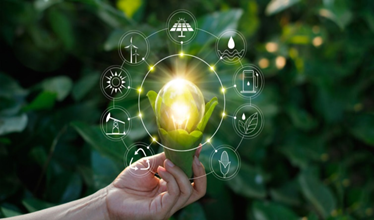Question on Green Technology
- Posted By
10Pointer
- Categories
Environment
- Published
11th Jul, 2022
-
-
Context
A recent study has flagged threats that can be emerged with the adoption of green technology, especially on the marine environment.
-
Background
- Owing to the climate change crises, the world has collectively diverted the focus of energy resources from fossil fuel-based to the green and clean energy.
- Along with the energy shift, to reduce the anthropogenic pollution, the use of biodegradable polymers is creating the space in daily human usages.
- In the process of implementation the use of green technology in gaining a significance in various applications, with an objective to protect and preserve the environment and climate.
- However, the method of implementation and adoption does not provide any scientifically proven litmus test to ensure no further degradation of the environment.
This brief aims to analyse the concept of green technology, its application and significance for the ecosystem.

-
Analysis
What is Green Technology?
- Green tech–or green technology–is an umbrella term that describes the use of technology and science to reduce human impacts on the natural environment.
- Green technology encompasses a wide area of scientific research, including energy, atmospheric science, agriculture, material science, and hydrology.
Objective resolutions of the Green Technology:
- Developing technologies that meet the needs of human beings without harming nature in any way.
- There are three concepts that have become highly relevant to the home in today's world - Use, Use and Reuse.
- This means that we must learn to reduce waste and production and reduce the consumption of natural resources.
- It is very important to produce products that can be fully recycled or reused.
- It is essential to develop alternative technologies to prevent further damage to health and the environment through changing patterns of production and consumption.
- Develop technologies that extend the range of biodegradable utility as much as possible.
Application of Green Technology:
Green technology can be applied in our daily life in so many ways:
- Waste Management as well as to purify air and water.
- It also opens new fields of renewable energy for every day uses like solar, wave, and wind energy.
- It can be applied for heating water, cooling homes, cooking and lighting.
- It can be applied in the manufacturing of appliances like computers. Electric cars, biogas plants and windmills are just some of the ways that green technology can be used.
-
How this green technology is beneficial to the ecosystem?
- Recycling: Green technology helps manage and recycle waste material. It allows it to be used for beneficial purposes. This technology is used for waste management, waste incineration, and more. A lot of recyclable material has allowed individuals to create plant fertilizer, sculptures, fuel, and even furniture.
|
Horizon scanning:
- It is a technique which seeks to identify novel but poorly known issues that are likely to become important consequences over the next decade.
- This methodology is meant to “primarily act as signposts, putting focus on particular issues and providing support for researchers and practitioners to seek investment in these areas” before they have a major impact.
- This methodology is meant to “primarily act as signposts, putting focus on particular issues and providing support for researchers and practitioners to seek investment in these areas” before they have a major impact.
|
- Purifying of Water: Green technology purifies water. The scarcity of pure drinking water is a major concern. Through the use of various technologies a lot of campaigns have been successful in providing people with clean drinking water.
- Purifying the Air: Dealing with carbon emission is another focus. While the human race is improving in terms of various technologies. The automobiles, factories, etc. are emitting a lot of carbon that is detrimental to the planet. Green technology helps to reduce carbon emission and purify the air. This allows people and other living things to breathe properly.
- Conserving Energy: Energy is being conserved through the use of such technology. Alternatives to devices that use a lot of electricity or fuel are being introduced to the public. The use of electric cars is on the rise, especially in the UK. People using environment friendly devices and appliances is encouraged. While installation of such devices, namely solar panels, might be expensive for some people the benefits it offers with regards to reducing bill expenses are tremendous.
- Rejuvenating Ecosystems: Green or Clean technology is also being used to breathe life into ecosystems that have sustained a lot of damage due to human involvement. Through the use of this technology tress are replanted, waste is managed and recycled. This ensures that the affected ecosystem is able to start again, and this time remains conserved. This helps to ensure that a lot of plant and animal species don’t go extinct.
-
What are the questions of concern regarding Green Technology?
- Demand for Lithium-ion: Growing demand for renewable energy technology, such as lithium batteries for electric cars, also pose a potential threat to marine ecology.
- Under water extraction: Deep sea ‘brine pools’ of more saline water, contain higher concentrations of lithium and could become future sites for extraction. A rising demand for lithium-powered electric vehicles could put these environments at risk.

- Biodegradable plastic bags: With increased public pressure against plastic marine pollution, there has been an attempt to replace fossil fuel-based plastics with biodegradable polymers, such as "biodegradable plastic bags" made from plant starches. These materials do not biodegrade under natural conditions in the ocean, and their widespread use can also cause marine litter. As their long-term impact on the environment remains unknown, they may lead to a new set of problems.
Potential challenges involved:
- Cost inefficiency: In terms of challenges, the main concern is the cost of renewable electricity from hydrogen in particular. Public investments must be well-strategized and directed.
- Furthermore, hydrogen is currently around $6-8/kg, which is too high a price to enter conventional use.
- Transportation: Another major obstacle is transporting hydrogen over long distances.
- Hydrogen in gaseous form is highly flammable.
- To transport liquid hydrogen, it must be cooled to -253 °C.
- Supply chain: For India to succeed as a renewable energy economy, it is not just the manufacturing sector where it wants to excel, but the entire supply chain.
- Currently, India has a solar PV module manufacturing capacity of approximately 2-3 gw.
- For the given 2030 targets of 450 GW of renewables, India needs 30-40 GW of renewable capacity increase per year, which requires:
- Maximum domestic production capacity
- Increase in duty on solar panels as it will incentivize domestic players in India to start manufacturing solar panels and make the entire supply chain robust.
-
Conclusion
With the growing push towards the green and clean policy measures and phasing the down the vehicular pollution, the demand for lithium ion and biodegradable polymers has increased. The implementation and adaptation process needs to be scientifically tested, so as to reduce the risk of new and fresh potential environmental threats.

